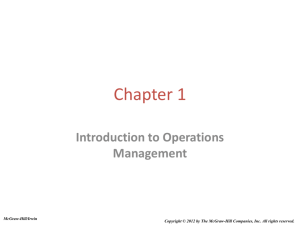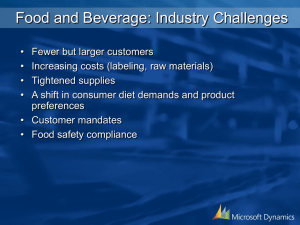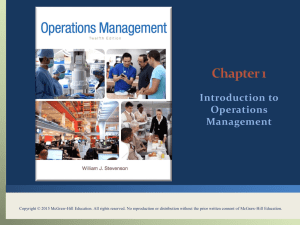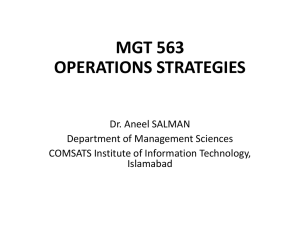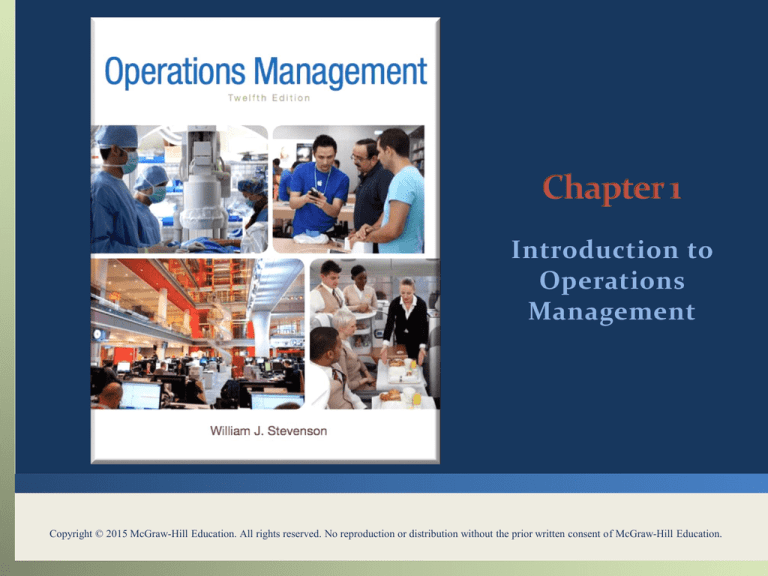
Introduction to
Operations
Management
Copyright © 2015 McGraw-Hill Education. All rights reserved. No reproduction or distribution without the prior written consent of McGraw-Hill Education.
You should be able to:
LO 1.1
LO 1.2
Define the terms operations management and supply chain
Identify similarities and differences between production and service
operations
LO 1.3 Explain the importance of learning about operations management
LO 1.4 Identify the three major functional areas of organizations and explain
how they interrelate
LO 1.5 Summarize the two major aspects of process management
LO 1.6 Describe the operations function and the nature of the operations
manager’s job
LO 1.7 Explain the key aspects of operations management decision making
LO 1.8 Briefly describe the historical evolution of operations management
LO 1.9 Describe the current issues in business that impact operations
management
LO 1.10 Explain the need to manage the supply chain
1-2
What is operations?
The part of a business organization that is responsible
for producing goods or services
How can we define operations management?
The management of systems or processes that create
goods and/or provide services
LO 1.1
1-3
Supply Chain – a sequence of activities and
organizations involved in producing and delivering
a good or service
Suppliers’
suppliers
LO 1.1
Direct
suppliers
Producer
Distributor
Final
Customers
1-4
Products are typically neither purely service- or purely goodsbased.
Goods
Services
Surgery, Teaching
Songwriting, Software Development
Computer Repair, Restaurant Meal
Home Remodeling, Retail Sales
Automobile Assembly, Steelmaking
LO 1.2
1-5
Every aspect of business affects or is affected by
operations
Many service jobs are closely related to operations
Financial services
Marketing services
Accounting services
Information services
Through learning about operations and supply chains
you will have a better understanding of:
The world you live in
The global dependencies of companies and nations
Reasons that companies succeed or fail
The importance of working with others
LO 1.3
1-6
Finance & Operations
Budgeting
Economic analysis of investment
proposals
Provision of funds
Marketing & Operations
Demand data
Product and service design
Competitor analysis
Lead time data
LO 1.4
1-7
Process - one or more actions that transform inputs into outputs
Three Categories of Business Processes:
LO 1.5
Upper-management processes
These govern the operation of the entire
organization.
Operational processes
These are core processes that make up the
value stream.
Supporting processes
These support the core processes.
1-8
The Operations Function consists of all activities
directly related to producing goods or providing
services.
A primary function of the operations manager is to
guide the system by decision making.
System Design Decisions
System Operation Decisions
LO 1.6
1-9
Most operations decisions involve many alternatives that can
have quite different impacts on costs or profits
Typical operations decisions include:
What: What resources are needed, and in what amounts?
When: When will each resource be needed? When should the work be
scheduled? When should materials and other supplies be ordered?
Where: Where will the work be done?
How: How will he product or service be designed? How will the work be
done? How will resources be allocated?
Who: Who will do the work?
LO 1.7
1-10
Performance Metrics
All managers use metrics to
manage and control operations
Profits
Costs
Quality
Productivity
Flexibility
Inventories
Schedules
Forecast accuracy
LO 1.7
Analysis of Trade-Offs
A trade-off is giving up one
thing in return for
something else
Carrying more inventory
(an expense) in order to
achieve a greater level of
customer service
1-11
Industrial Revolution
Scientific Management
Human Relations Movement
Decision Models and Management Science
Influence of Japanese Manufacturers
LO 1.8
1-12
Economic conditions
Innovating
Quality problems
Risk management
Competing in a global economy
LO 1.9
1-13
In the past, organizations did little to manage the
supply chain beyond their own operations and
immediate suppliers which led to numerous problems:
Oscillating inventory levels
Inventory stockouts
Late deliveries
Quality problems
LO 1.10
1-14
1.
2.
3.
4.
5.
6.
7.
8.
The need to improve operations
Increasing levels of outsourcing
Increasing transportation costs
Competitive pressures
Increasing globalization
Increasing importance of e-business
The complexity of supply chains
The need to manage inventories
LO 1.10
1-15

